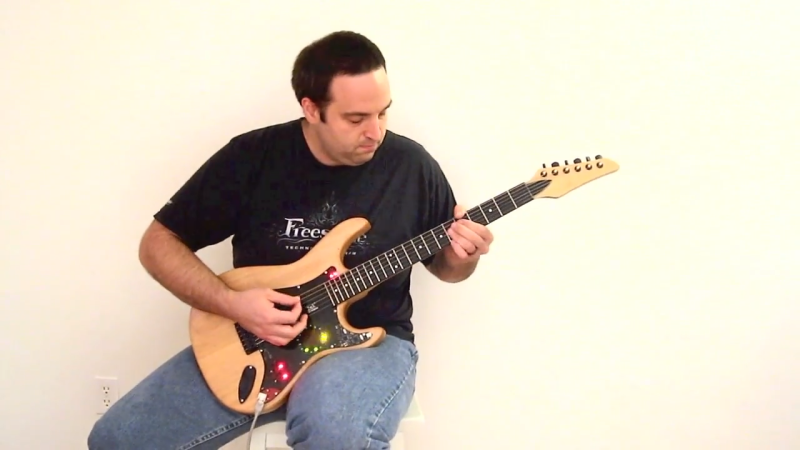Much discussion goes on in the guitar world about the best hardware to use. Whether its pickups, how they’re positioned, or even the specific breed of wood on the fretboard, it’s all up for debate. [Eli Hughes] put much of that to one side, however, with his innovative “Active Pickguard” project.
The project reimagines the electronics of an electric guitar from the ground up. Instead of typical electromagnetic pickups, six individual piezo pickups are built into the bridge – one for each individual string. The outputs of these pickups is conditioned and then read by the analog-to-digital converter of a Freescale Kinetis K40. The DSP-capable chip can then be used to apply all manner of effects. [Eli] demonstrates the guitar providing an uncanny imitation of an acoustic guitar, before demonstrating jazz and overdrive tones as well.
The Kinetis chip also features touch-sensitive inputs, which [Eli] put to good use. All the hardware is built into a pickguard-shaped PCB, complete with touch controls for things like volume, tone, and choosing different DSP patches.
Unlike a regular guitar, this one needs a power supply, which it gets via a CAT 6 cable, in place of the usual 1/4″ guitar cable. The CAT 6 also carries audio out to a converter box which allows the audio to be output to a regular guitar amplifier.
It’s a neat build, and one that shows just how modern technology can reimagine a simple 20th-century instrument. DSP really is magic, after all. Video after the break.
\
















Line-6 have been doing this for years; love my bass. Pretty impressive as a DIY though!
This project is from 10 years ago.
BTW, woods don’t come in “breeds”, they’re species.
I will watch the longer video later for the appparently well-done overview of DSP, but yeah it’s a 10 year-old project. (And ZOOM also made/makes DSP processors for instruments; i have one from 15 years ago)
And please, is it too much to ask for more than just a link to some videos? I visited both video pages, and scanned thru the videos… there’s no links to the actual project!
from the article:
> uncanny imitation of an acoustic guitar,
… I was listening to the video audio up and down in search for that, couldn’t find it. Then I realized, the author of the article was referring to the electric guitar sounding electric guitar that somewhat tried an uninspired “semi-acoustic” guitar sound. Nothing “uncanny” about it, it simply doesn’t sound like an acoustic *at* *all* (or maybe a poorly picked-up one, pun intended).
I love the project (and did back when it was first featured on musicians’ sites), but it still does not SOUND good. Like … not-at-all-good.
Uhhh, well, I’ll keep my cheap Zoom pedal. But it would be nice to have an update to this project to see what’s improved after ten years. Lower power would be nice. Using a single cable would be nice, not a CAT6; pipe both the DC and digital signal through it. Worst case, a stereo 1/4 inch cable with a power conductor. Did I mention how much I hate batteries? l